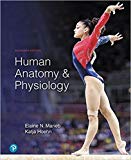
Human Anatomy & Physiology Plus Modified Mastering A&P with Pearson eText -- Access Card Package 11th edition
11th Edition
ISBN: 9780135175040
Author: Marieb
Publisher: PEARSON
expand_more
expand_more
format_list_bulleted
Question
Chapter 19, Problem 5RQ
Summary Introduction
Introduction:
Blood vessels inside the living organisms are responsible for making a delivery system inside the body of an organism. Three major type of blood vessels present in the body are the arteries, the capillaries, and the veins. The arteriolar system carries the blood away from the heart and the veins carry blood toward the heart inside the body. The contraction and relaxation of the blood vessels result in the increased or decreased amount of surface area of the blood vessels.
Expert Solution & Answer
Want to see the full answer?
Check out a sample textbook solution
Students have asked these similar questions
(This is a 2-part work, Part 1 is done, only Part 2 is to be worked on at the bottom)Part 1 (Done): Describe the levels of structural hierarchy for the human body, starting with the organismal level and ending with the chemical level. In addition, you should make sure you link each level to the previous level, emphasizing the structural relationships.
The human body is organized into a structural hierarchy that progresses from the macroscopic organismal level down to the microscopic chemical level. Each level builds upon the previous one, creating increasingly complex structures. Below is the hierarchy, from largest to smallest, with explanations linking each level to its predecessor:
1. Organismal Level
The entire living human body.Relationship: All lower levels work together to sustain life at this highest level.
2. Organ System Level
Groups of organs working together to perform major functions.Examples: circulatory, nervous, digestive systems.Relationship: The organismal…
Describe the levels of structural hierarchy for the human body, starting with the organismal level and ending with the chemical level. In addition, you should make sure you link each level to the previous level, emphasizing the structural relationships.
9
S
es
Read the section "Investigating Life: In (Extremely) Cold Blood." Then, drag and drop the terms on the left to complete the concept
map.
Red blood cells
Genes
Icefishes
-have mutated
have colorless
Oxygen
have few
lack
encode
Blood
Cellular
respiration
consists of-
contain
carries
is a
Platelets
White blood
cells
carries
low
amounts
of
Hemoglobin
is necessary for
Plasma
Protein
Reset.
Chapter 19 Solutions
Human Anatomy & Physiology Plus Modified Mastering A&P with Pearson eText -- Access Card Package 11th edition
Ch. 19 - Prob. 1RQCh. 19 - 3. Peripheral resistance (a) is inversely...Ch. 19 - 4. Which of the following can lead to decreased...Ch. 19 - 5. Arterial blood pressure increases in response...Ch. 19 - Prob. 5RQCh. 19 - 7. The structure of a capillary wall differs from...Ch. 19 - Prob. 7RQCh. 19 - 9. The myocardium receives its blood supply...Ch. 19 - 10. Blood flow in the capillaries is steady...Ch. 19 - Prob. 10RQ
Ch. 19 - Prob. 12RQCh. 19 - Prob. 11RQCh. 19 - Prob. 13RQCh. 19 - Prob. 19RQCh. 19 - 17. Write an equation showing the relationship...Ch. 19 - Prob. 17RQCh. 19 - Prob. 14RQCh. 19 - Prob. 15RQCh. 19 - Prob. 21RQCh. 19 - Prob. 22RQCh. 19 - 22. Describe neural and chemical (both systemic...Ch. 19 - How are nutrients, wastes, and respiratory gases...Ch. 19 - Prob. 18RQCh. 19 - Prob. 24RQCh. 19 - 2. Your friend Jillian, who knows little about...Ch. 19 - 3. The Agawam High School band is playing some...Ch. 19 - 4. When we are cold or the external temperature is...Ch. 19 - 5. Edema is a common clinical problem. On your...Ch. 19 - Prob. 1CCSCh. 19 - Prob. 2CCSCh. 19 - Prob. 3CCSCh. 19 - Prob. 4CCSCh. 19 - Prob. 5CCSCh. 19 - Prob. 6CCS
Knowledge Booster
Similar questions
- Plating 50 microliters of a sample diluted by a factor of 10-6 produced 91 colonies. What was the originalcell density (CFU/ml) in the sample?arrow_forwardEvery tutor here has got this wrong, don't copy off them.arrow_forwardSuppose that the population from question #1 (data is in table below) is experiencing inbreeding depression (F=.25) (and no longer experiencing natural selection). Calculate the new expected genotype frequencies (f) in this population after one round of inbreeding. Please round to 3 decimal places. Genotype Adh Adh Number of Flies 595 Adh Adh 310 Adhs Adhs 95 Total 1000 fladh Adh- flAdn Adh fAdhs Adharrow_forward
- Which of the following best describes why it is difficult to develop antiviral drugs? Explain why. A. antiviral drugs are very difficult to develop andhave no side effects B. viruses are difficult to target because they usethe host cell’s enzymes and ribosomes tometabolize and replicate C. viruses are too small to be targeted by drugs D. viral infections usually clear up on their ownwith no problemsarrow_forwardThis question has 3 parts (A, B, & C), and is under the subject of Nutrition. Thank you!arrow_forwardThey got this question wrong the 2 previous times I uploaded it here, please make sure it's correvct this time.arrow_forward
- This question has multiple parts (A, B & C), and under the subject of Nutrition. Thank you!arrow_forwardCalculate the CFU/ml of a urine sample if 138 E. coli colonies were counted on a Nutrient Agar Plate when0.5 mls were plated on the NA plate from a 10-9 dilution tube. You must highlight and express your answerin scientific notatioarrow_forwardDon't copy off the other answer if there is anyarrow_forward
arrow_back_ios
SEE MORE QUESTIONS
arrow_forward_ios
Recommended textbooks for you
 Human Physiology: From Cells to Systems (MindTap ...BiologyISBN:9781285866932Author:Lauralee SherwoodPublisher:Cengage Learning
Human Physiology: From Cells to Systems (MindTap ...BiologyISBN:9781285866932Author:Lauralee SherwoodPublisher:Cengage Learning Human Biology (MindTap Course List)BiologyISBN:9781305112100Author:Cecie Starr, Beverly McMillanPublisher:Cengage Learning
Human Biology (MindTap Course List)BiologyISBN:9781305112100Author:Cecie Starr, Beverly McMillanPublisher:Cengage Learning

Human Physiology: From Cells to Systems (MindTap ...
Biology
ISBN:9781285866932
Author:Lauralee Sherwood
Publisher:Cengage Learning





Human Biology (MindTap Course List)
Biology
ISBN:9781305112100
Author:Cecie Starr, Beverly McMillan
Publisher:Cengage Learning